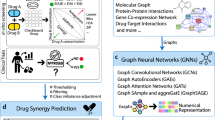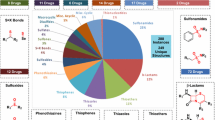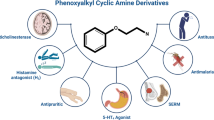Abstract
A series of 53 1,2,4-benzotriazines as inhibitors of the sarcoma family of protein tyrosine kinases have been studied. The Monte Carlo method has been used as a tool to build up the quantitative structure–activity relationships for appropriate inhibition activity. The QSAR models were calculated with the representation of the molecular structure by the simplified molecular input-line entry system. Three various splits into training and test sets have been examined. The statistical quality of all build models is very good. The best calculated model had following statistical parameters: r 2 = 0.9843, q 2 = 0.9831 for the training set and r 2 = 0.9488, q 2 = 0.9300 for the test set. The structural indicators (alerts) for the increase and decrease in the inhibition activity have been defined. The computer-aided design of new potential sarcoma inhibitor derivatives has been presented by using defined structural alerts.



Similar content being viewed by others
References
Aligayer H, Boyd DD, Heiss MM, Abdalla EK, Curley SA, Gallick GE (2002) Activation of Src kinase in primary colorectal carcinoma: an indicator of poor clinical prognosis. Cancer 94:344–351
Belsches-Jablonski AP, Biscardi JS, Peavy DR, Tice DA, Romney DA, Parsons SJ (2001) Src family kinases and HER2 interactions in human breast cancer cell growth and survival. Oncogene 20:1465–1475
Daylight Chemical Information Systems, Inc (2008) http://www.daylight.com. Accessed 10 Nov 2013
Golbraikh A, Tropsha A (2002) Beware of q2! J Mol Graph Model 20:269–276
Goulon A, Picot T, Duprat A, Dreyfus G (2007) Predicting activities without computing descriptors: graph machines for QSAR. SAR QSAR Environ Res 18:141–153
Gueto C, Ruiz JL, Torres JE, Mendez J, Vivas-Reyes R (2008) Three-dimensional quantitative structure–activity relationship studies on novel series of benzotriazine based compounds acting as Src inhibitors using CoMFA and CoMSIA. Bioorg Med Chem 16:2439–2447
Hansch C, Hoekman D, Gao H (1996) Comparative QSAR: toward a deeper understanding of chemicobiological interactions. Chem Rev 96:1045–1076
Ivanciuc O (2000) QSAR comparative study of wiener descriptors for weighted molecular graphs. J Chem Inf Comput Sci 40:1412–1422
Ivanciuc O (2013) Chemical graphs, molecular matrices and topological indices in chemoinformatics and quantitative structure–activity relationships. Curr Comput-Aid Drug 9:153–163
Katritzky AR, Petrukhin R, Tatham D, Basak SC, Benfenati E, Karelson M, Maran U (2001) Interpretation of quantitative structure–property and –activity relationships. J Chem Inf Comput Sci 41:679–685
Lv JL, Wang R, Liu D, Guo G, Jing YK, Zhao LX (2008) Design, synthesis, and antitumor activities of some novel substituted 1,2,3-benzotriazines. Molecules 13:1427–1440
MacMillan-Crow LA, Greendorfer JS, Vickers SM, Thompson JA (2000) Tyrosine nitration of c-SRC tyrosine kinase in human pancreatic ductal adenocarcinoma. Arch Biochem Biophys 377:350–356
Noronha G, Barrett K, Cao J, Dneprovskaia E, Fine R, Gong X, Gritzen C, Hood J, Kang X, Klebansky B, Li G, Liao W, Lohse D, Mak CC, McPherson A, Palanki MS, Pathak VP, Renick J, Soll R, Splittgerber U, Wrasidlo W, Zeng B, Zhao N, Zhou Y (2006) Discovery and preliminary structure–activity relationship studies of novel benzotriazine based compounds as Src inhibitors. Bioorg Med Chem Lett 16:5546–5550
OECD (2007) Guidance document on the validation of (quantitative) structure–activity relationships [(Q)Sar] models. http://www.oecd.org/dataoecd/55/35/38130292.pdf
Ojha PK, Roy K (2011) Comparative QSARs for antimalarial endochins: importance of descriptor-thinning and noise reduction prior to feature selection. Chemometr Intell Lab 109:146–161
Ojha PK, Mitra I, Das RN, Roy K (2011) Further exploring rm 2 metrics for validation of QSPR models. Chemometr Intell Lab 107:194–205
Palanki MSS, Cao J, Chow CP, Dneprovskaia E, Mak CC, McPherson A, Pathak VP, Renick J, Soll R, Zeng B, Noronha G (2009) Development of novel benzotriazines for drug discovery. Exp Opin Drug Dis 4:33–49
Roy K (2007) On some aspects of validation of predictive quantitative structure activity relationship models. Expert Opin Drug Dis 2:1567–1577
Roy PP, Roy K (2009) QSAR studies of CYP2D6 inhibitor aryloxypropanolamines using 2D and 3D descriptors. Chem Biol Drug Des 73:442–455
Roy PP, Leonard JT, Roy K (2008) Exploring the impact of the size of training sets for the development of predictive QSAR models. Chemometr Intell Lab 90:31–42
Şahin K, Sarıpınar E, Yanmaz E, Geçen N (2011) Quantitative bioactivity prediction and pharmacophore identification for benzotriazine derivatives using the electron conformational-genetic algorithm in QSAR. SAR QSAR Environ Res 22:217–238
Summy JM, Gallick GE (2003) Src family kinases in tumor progression and metastasis. Cancer Metast Rev 22:337–358
Tintori C, Magnani M, Schenone S, Botta M (2009) Docking, 3D–QSAR studies and in silico ADME prediction on c-Src tyrosine kinase inhibitors. Eur J Med Chem 44:990–1000
Toropov AA, Benfenati E (2007) SMILES as an alternative to the graph in QSAR modelling of bee toxicity. Comput Bio Chem 31:57–60
Toropov AA, Benfenati E (2008) Additive SMILES-based optimal descriptors in QSAR modelling bee toxicity: using rare SMILES attributes to define the applicability domain. Bioorg Med Chem 16:4801–4809
Toropov AA, Toropova AP, Raska I Jr (2008) QSPR modeling of octanol/water partition coefficient for vitamins by optimal descriptors calculated with SMILES. Eur J Med Chem 43:714–740
Toropov AA, Toropova AP, Lombardo A, Roncaglioni A, Benfenati E, Gini G (2011) CORAL: building up the model for bioconcentration factor and defining it’s applicability domain. Eur J Med Chem 46:1400–1403
Toropov AA, Toropova AP, Benfenati E, Fanelli R (2013a) The definition of the molecular structure for potential anti-malaria agents by the Monte Carlo method. Struct Chem 24:1369–1381
Toropov AA, Toropova AP, Puzyn T, Benfenati E, Gini G, Leszczynska D, Leszczynski J (2013b) QSAR as a random event: modeling of nanoparticles uptake in PaCa2 cancer cells. Chemosphere 92:31–37
Tropsha A (2010) Best practices for QSAR model development, validation, and exploitation. Mol Inform 29:476–488
Ullrich A, Schlessinger J (1990) Signal transduction by receptors with tyrosine kinase activity. Cell 61:203–212
Veselinović AM, Milosavljević JB, Toropov AA, Nikolić GM (2013a) SMILES-based QSAR models for arylpiperazines as high-affinity 5-HT1A receptor ligands using CORAL. Eur J Pharm Sci 48:532–541
Veselinović AM, Milosavljević JB, Toropov AA, Nikolić GM (2013b) SMILES-based QSAR models for the calcium channel antagonistic effect of 1,4-dihydropyridines. Arch Pharm 346:134–139
Acknowledgments
This work has been financially supported by the Ministry of Education and Science, Republic of Serbia, under Project Number 31060.
Conflict of interest
We declare no conflict of interest.
Author information
Authors and Affiliations
Corresponding author
Electronic supplementary material
Below is the link to the electronic supplementary material.
44_2014_1132_MOESM1_ESM.xls
Table S1 Structures of 53 examined 1,2,4-benzotriazines as Src inhibitors represented with SMILES notations, calculated values for DCW, the experimental activity data (Ac)—expr, calculated values for A c with application of CORAL—calc and difference between expr and calc for best models for three splits (XLS 47 kb)
44_2014_1132_MOESM3_ESM.docx
Table S3 Example of DCW(0,12) calculation from the best model represented in Table 1. The representation of molecular structure with SMILES notation by SMILES attributes for molecule (DOCX 48 kb)
44_2014_1132_MOESM4_ESM.xls
Table S4 Total list of the SAk together with correlation weights for the three probes of the Monte Carlo optimization for three splits (XLS 98 kb)
Rights and permissions
About this article
Cite this article
Toropov, A.A., Veselinović, J.B., Veselinović, A.M. et al. QSAR models for 1,2,4-benzotriazines as Src inhibitors based on Monte Carlo method. Med Chem Res 24, 283–290 (2015). https://doi.org/10.1007/s00044-014-1132-8
Received:
Accepted:
Published:
Issue Date:
DOI: https://doi.org/10.1007/s00044-014-1132-8




